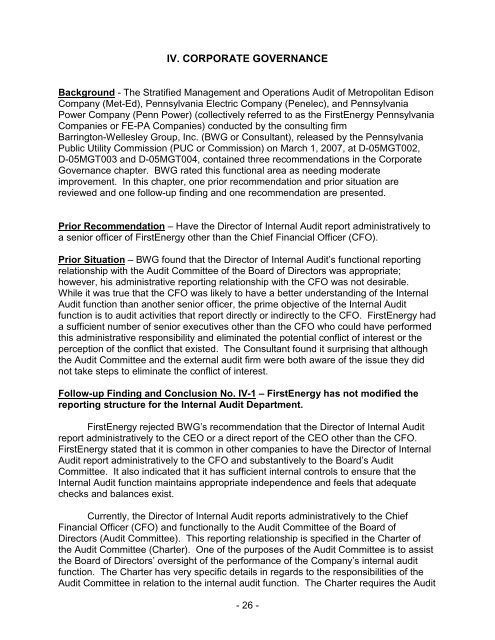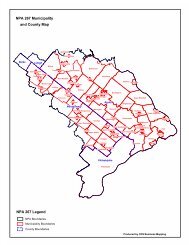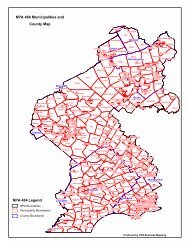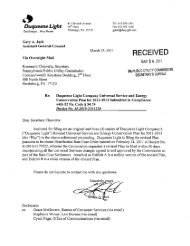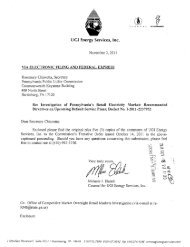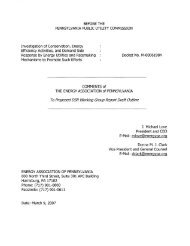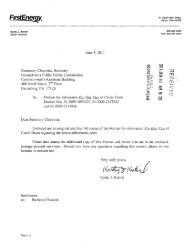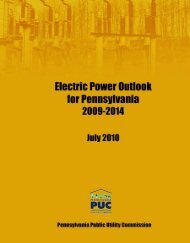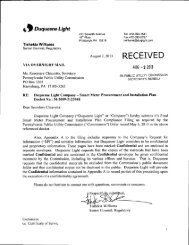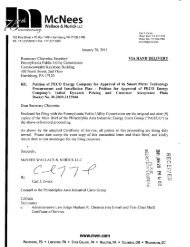METROPOLITAN EDISON COMPANY - Pennsylvania Public Utility ...
METROPOLITAN EDISON COMPANY - Pennsylvania Public Utility ...
METROPOLITAN EDISON COMPANY - Pennsylvania Public Utility ...
- No tags were found...
Create successful ePaper yourself
Turn your PDF publications into a flip-book with our unique Google optimized e-Paper software.
IV. CORPORATE GOVERNANCEBackground - The Stratified Management and Operations Audit of Metropolitan EdisonCompany (Met-Ed), <strong>Pennsylvania</strong> Electric Company (Penelec), and <strong>Pennsylvania</strong>Power Company (Penn Power) (collectively referred to as the FirstEnergy <strong>Pennsylvania</strong>Companies or FE-PA Companies) conducted by the consulting firmBarrington-Wellesley Group, Inc. (BWG or Consultant), released by the <strong>Pennsylvania</strong><strong>Public</strong> <strong>Utility</strong> Commission (PUC or Commission) on March 1, 2007, at D-05MGT002,D-05MGT003 and D-05MGT004, contained three recommendations in the CorporateGovernance chapter. BWG rated this functional area as needing moderateimprovement. In this chapter, one prior recommendation and prior situation arereviewed and one follow-up finding and one recommendation are presented.Prior Recommendation – Have the Director of Internal Audit report administratively toa senior officer of FirstEnergy other than the Chief Financial Officer (CFO).Prior Situation – BWG found that the Director of Internal Audit’s functional reportingrelationship with the Audit Committee of the Board of Directors was appropriate;however, his administrative reporting relationship with the CFO was not desirable.While it was true that the CFO was likely to have a better understanding of the InternalAudit function than another senior officer, the prime objective of the Internal Auditfunction is to audit activities that report directly or indirectly to the CFO. FirstEnergy hada sufficient number of senior executives other than the CFO who could have performedthis administrative responsibility and eliminated the potential conflict of interest or theperception of the conflict that existed. The Consultant found it surprising that althoughthe Audit Committee and the external audit firm were both aware of the issue they didnot take steps to eliminate the conflict of interest.Follow-up Finding and Conclusion No. IV-1 – FirstEnergy has not modified thereporting structure for the Internal Audit Department.FirstEnergy rejected BWG’s recommendation that the Director of Internal Auditreport administratively to the CEO or a direct report of the CEO other than the CFO.FirstEnergy stated that it is common in other companies to have the Director of InternalAudit report administratively to the CFO and substantively to the Board’s AuditCommittee. It also indicated that it has sufficient internal controls to ensure that theInternal Audit function maintains appropriate independence and feels that adequatechecks and balances exist.Currently, the Director of Internal Audit reports administratively to the ChiefFinancial Officer (CFO) and functionally to the Audit Committee of the Board ofDirectors (Audit Committee). This reporting relationship is specified in the Charter ofthe Audit Committee (Charter). One of the purposes of the Audit Committee is to assistthe Board of Directors’ oversight of the performance of the Company’s internal auditfunction. The Charter has very specific details in regards to the responsibilities of theAudit Committee in relation to the internal audit function. The Charter requires the Audit- 26 -


